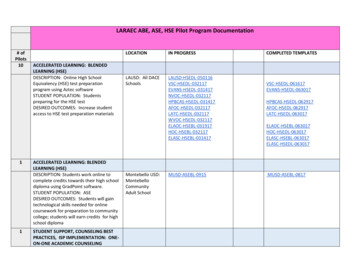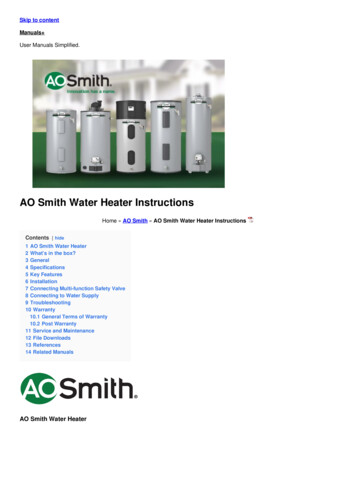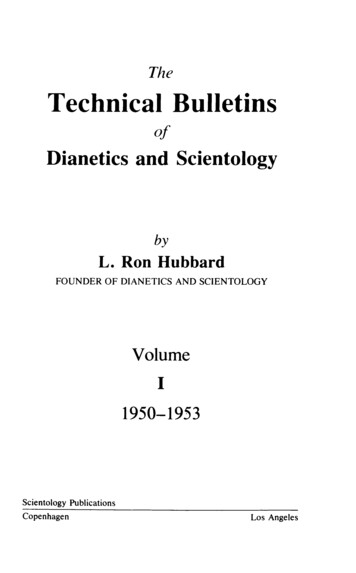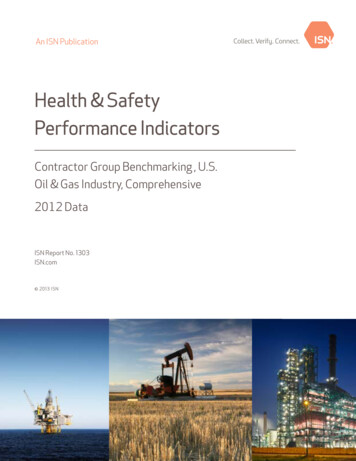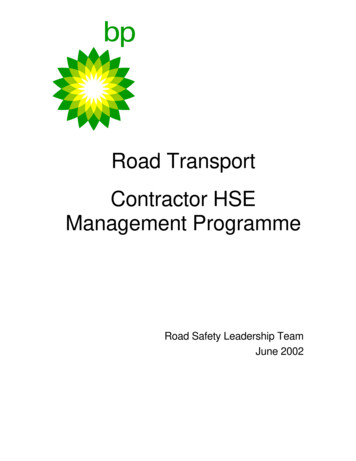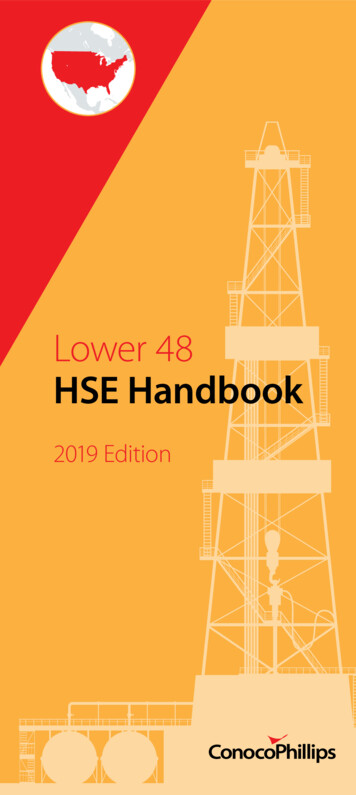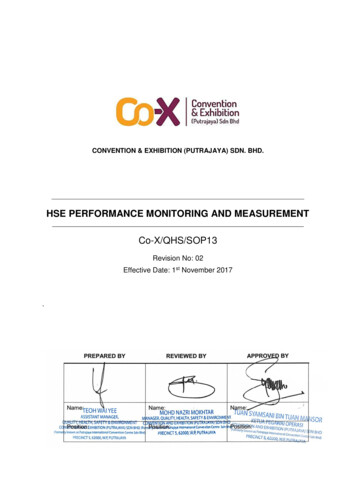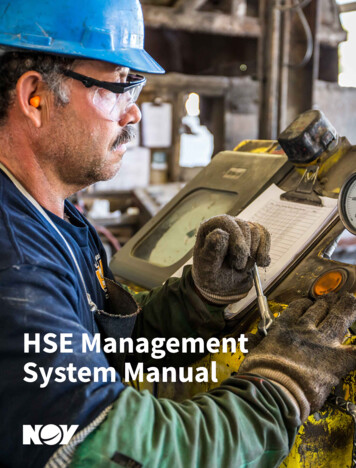
Transcription
HSEManagementSystem Manual
Table of Contents3Introduction1 Scope52 References73 Terms and Definitions74 Context of the Organization105 Leadership Responsibilities and Employee Participation126 Planning147 Support188 Operation209 Performance Evaluation2310 Improvement25 2016 NOV. All Rights Reserved.NOV HSE Management System Manual 2
INTRODUCTIONoThe items within this introduction section are meant to provide an overview of an HSE MS and are notconsidered requirements and therefore shall not be auditable.BACKGROUNDoFundamentally, organizations are responsible for the health and safety of workers and others, and thesustainability and protection of the environment. The adoption of this HSE MS will provide safe and healthyworkplaces, prevent work-related injury and ill health and continually improve HSE performance.oThis NOV HSE MS provides our organization with a framework for managing HSE risks and opportunities forprotecting people and the environment and responding to changing conditions in balance with socioeconomic needs. It specifies requirements that will enable our organization to achieve the intended outcomeswe have set for the HSE MS.oThe intended outcomes of the HSE MS are to prevent work-related injury and ill health people, protect theenvironment, and provide safe and healthy workplaces. Consequently, it is critically important that thelocation eliminate hazards and minimize HSE risks by taking preventive and protective measures.oImplementing this HSE MS enables a location to manage its HSE risks, improve its HSE performance, and assistwith the fulfillment of legal, compliance, and other requirements.AIMSUCCESS FACTORSoThis HSE MS enables NOV Top Management to effectively address HSE risks and opportunities by integratingHSE management into business processes, strategic direction and decision making, aligning them with otherbusiness priorities, and incorporating HSE governance into its overall management system.oThe implementation of this HSE MS is a strategic and operational decision for our organization. The success ofthis HSE MS depends on leadership, commitment and participation from all levels and functions of theorganization.oThe implementation and maintenance of this HSE MS, its effectiveness and its ability to achieve its intendedoutcomes are dependent on key factors such as: Top management leadership, commitment, responsibilities and accountability;Top management developing, leading and promoting a culture in the organization that supports theintended outcomes of the HSE management system;Communication;Consultation and participation of workers, and, where they exist, workers’ representatives;Allocation of the necessary resources to maintain it;HSE policies, which are compatible with the overall strategic objectives and direction of theorganization;Effective process(es) for identifying hazards, controlling HSE risks and taking advantage of HSEopportunities;Continual performance evaluation and monitoring of the HSE management system to improve OH&Sperformance;Integration of the OH&S management system into the organization’s business processes;Compliance with legal and other requirements; and,HSE objectives that align with the HSE policy and consider the organization’s hazards, HSE risks andHSE opportunities.PLAN-DO-CHECK-ACToThe NOV HSE MS is structured under the Plan-Do-Check-Act (“PDCA”) model which is based upon internationalstandards, including ISO 14001 and ISO 45001. The PDCA is a process that is repeated to achieve continualimprovement. It can be briefly described as follows. 2016 NOV. All Rights Reserved.NOV HSE Management System Manual 3
Plan: determine and assess risks and opportunities, establish HSE objectives and processes necessaryto deliver results in accordance with NOV HSE Policy.Do: implement the processes as planned.Check: monitor and measure processes and activities against the NOV HSE Policy, including itscommitments, HSE objectives and operating criteria, and report the results.Act: take actions to continually improve HSE performance to achieve the intended outcomes.CLARIFICATION AND GUIDANCEoooooooWithin this document the use of “Business Segment (SEG), Business Unit (BU), and / or Location (LOC)” and “TopManagement” are used when describing responsibility for establishing, implementing, and maintaining. Where theformer is used it is expected the latter is responsible for the establishing, implementing, and maintaining processes.In addition to the terms and definitions given in section 3, clarification of the selected concepts below is provided as anaid to prevent misunderstanding.In this health, safety, environmental management system, the use of the word “any” implies selection or choice.The words “appropriate” and “applicable” are not interchangeable. “Appropriate” means suitable for or to, and impliessome degree of freedom, while “applicable” means relevant or possible to apply and implies that if it can be done, itneeds to be done.The word “consider” means it is necessary to think about the topic, but it can be excluded; whereas “take into account”means it is necessary to think about the topic, but it cannot be excluded.“Continual” indicates duration that occurs over a period, but with intervals of interruption (unlike “continuous” whichindicates duration without interruption). “Continual” is therefore the appropriate word to use when referring toimprovement.In this HSE MS, the word “effect” is used to describe the result of a change to the organization. The phrase “environmentalimpact” refers specifically to the result of a change to the environment, whether positive or negative. 2016 NOV. All Rights Reserved.NOV HSE Management System Manual 4
ooooooooooooThe word “ensure” means the responsibility can be delegated, but the accountability cannot be delegated.The term “interested party” and the term “stakeholder” is a synonym as it represents the same concept.The phrase “compliance obligations” replaces and does not differ from the phrase “legal requirements and otherrequirements to which the organization subscribes”. A compliance obligation is a requirement. There are two kinds ofcompliance obligations: mandatory compliance obligations (which include laws and regulations) and voluntarycompliance obligations (which include contractual commitments, community and industry standards, ethical codes ofconduct, and good governance guidelines). A voluntary obligation becomes mandatory once you decide to comply withit.“Documented information” replaces the words “documentation”, “documents” and “records” used in previous HSEStandards. To distinguish the intent of the generic term “documented information”, this HSE MS uses the phrase “retaindocumented information as evidence of .” to mean records, and “maintain documented information” to meandocumentation other than records. The phrase “as evidence of .” is not a requirement to meet legal evidentiaryrequirements; its intent is only to indicate objective evidence needs to be retained.The phrase “external provider” means an external supplier organization (which includes a contractor) that provides aproduct or a service.The word “determine” implies a discovery process that results in knowledge.The phrase “intended outcome” is what the organization intends to achieve by implementing its HSE MS. The minimalintended outcomes include enhancement of HSE performance, fulfilment of compliance obligations and achievement ofHSE objectives.The phrase “person(s) doing work under its control” includes persons working for the organization and those working onits behalf for which the organization has responsibility (i.e. contractors). It replaces the phrase “persons working for it oron its behalf” and “persons working for or on behalf of the organization” used in older International Standards.The verbal form “shall” indicates a requirement.The verbal form “should” indicates a recommendation.The verbal form “may” indicates a permission.The verbal form “can” indicates a possibility or a capability.1 SCOPE1.1This HSE MS Manual identifies the framework needed to design an HSE MS and serves as guidance to anySEG, BU or LOC creating an HSE MS. Each SEG, BU, and / or LOC will be responsible to define the scope of theirHSE MS, and the design and intent of the HSE MS itself.1.2This document can be used in whole or in part. However, claims of conformity to this document are notacceptable unless all its requirements are incorporated into the HSE MS implemented by the SEG, BU, and /or LOC and fulfilled without exclusion.1.3A cross-reference list of the supporting processes correlating to the requirements outlined within this Manualshould be created by the SEG, BU, and / or LOC.1.4This HSE MS manual applies to the OH&S risks under the organization’s control, taking into account factorssuch as the organization’s operations and the needs and expectations of its workers and other interestedparties AND applies to the environmental aspects of its activities, products and services that the organizationdetermines it can either control or influence considering a life cycle perspective. .1.5This HSE MS does not address issues such as product safety or property damage, beyond the risks to workersand other relevant interested parties.1.6The framework by which the HSE Management System will model includes:1.6.1The HSE Policy Statement and this HSE MS Manual as the foundation of the NOV HSE MS. The HSEPolicy Statement and HSE MS Manual are also referred to as “Level 1”. 2016 NOV. All Rights Reserved.NOV HSE Management System Manual 5
1.6.2Operational Controls that detail how the SEG or BU aligns their operations with this HSE MS Manual.Operational Controls are referred to as “Level 2”.1.6.3LOC-Specific Procedures and Work Instructions that detail how each LOC aligns their operations toSEG, BU, regulatory and other requirements. LOC Specific Procedures and Work Instructions arereferred to as “Level 3”.1.7All supporting documents are to be maintained in accordance with this HSE MS as appropriate.1.8SEG, BU, and/or LOC following this HSE MS shall implement and maintain, either all or in part as allowed perSection 1.2, the following processes and where necessary operational control:1.8.1Roles, Responsibilities, and Authorities (Section 5);1.8.2Consultation and Participation (Section 5);1.8.3Hazard Identification, Risk Assessment, and Controls (Section 6);1.8.4Environmental Aspects and Impacts (Section 6);1.8.5Legal, Compliance Obligations, and Other Requirements (Section 6);1.8.6Objectives and Targets (Section 6);1.8.7Competence, Training, and Awareness (Section 7);1.8.8Communication (Section 7);1.8.9Documented Information (Section 7);1.8.10 Process Specific Operational Controls (as applicable) (Section 8);1.8.11 Emergency Preparedness and Response (Section 8); 2016 NOV. All Rights Reserved.NOV HSE Management System Manual 6
1.8.12 Management of Change (Section 8);1.8.13 Management of Contractors, Procurement, & Outsourcing (Section 8);1.8.14 Monitoring, Measurement, Analysis, and Evaluation (Section 9);1.8.15 Internal Audits and Assessments (Section 9);1.8.16 Evaluation of Compliance (Section 9);1.8.17 Management Review (Section 9); and / or,1.8.18 Incidents, Nonconformity, Corrective and Preventive Action (Section 10).1.9SEG, BU, or LOC opting to implement Sections of this manual, as allowed per Sub-Section 1.2, shall implementthe corresponding process above.2 REFERENCES2.1ISO 14001:2015 Environmental management systems2.2ISO 45001:2018 Occupational health and safety management systems3 TERMS AND DEFINITIONS3.1The following terms and definitions apply for the purposes of this HSE MS.3.2AUDIT: A systematic, independent, and documented process for obtaining audit evidence and evaluating itobjectively to determine the extent to which the audit criteria are fulfilled.3.3AUDITOR: A person(s) who conducts an audit and is under the direction of a Lead Auditor.3.4AUDITOR, LEAD: A person qualified to organize and lead others in the methods used to conduct audits,responsible for conducting the evaluation and reporting of audit findings.3.5AUTHORITY: Person given the permission to make changes and updates as it pertains to the HSE MS.3.6BUSINESS SEGMENT: The reporting segments within NOV. Referenced as SEG within this document.3.7BUSINESS UNIT: A division of an NOV Business Segment. Referenced as BU within this document.3.8COMPETENCE: The ability to apply knowledge and skills to achieve intended results.3.9COMPLIANCE: Complying with applicable laws, regulations, standards, and other requirements.3.10 COMPLIANCE OBLIGATION: Legal requirements that an organization must comply with and otherrequirements that an organization must or chooses to comply with.3.11 CONFORMANCE or CONFORMITY: Fulfilment of a specified HSE MS requirements.3.12 CONSULTATION: Seeking views of interested parties before making a decision.3.13 CONTINUAL IMPROVEMENT: Recurring activity to enhance performance.3.14 CONTRACTOR: External organization providing services to the organization in accordance with agreedspecifications, terms and conditions.3.15 CORRECTIVE ACTION: Measures taken to eliminate conditions adverse to the environment and/or health andsafety to minimize and prevent the recurrence of those conditions.3.16 DOCUMENTED INFORMATION: Any written, electronic, or pictorial information required to be created,controlled, and maintained for the organization to operate including the HSE management system, 2016 NOV. All Rights Reserved.NOV HSE Management System Manual 7
requirements (operational controls, procedures, work instructions, etc.), related processes, and objectiveevidence of results achieved (records).3.17 DOCUMENT AND DATA CONTROL: A process to ensure that documents are distributed, revised, or replacedper a control procedure which assures that the document or manual reflects all current requirements.3.18 EFFECTIVENESS: Extent to which planned activities are realized and planned results achieved.3.19 EMPLOYEE: Personnel on the NOV payroll and under the direct control and influence of the organization.3.20 ENVIRONMENT: Surroundings, extending from within an organization to the global system, in which anorganization operates including air, water, land, natural resources, flora, fauna, humans, and theirinterrelation.3.21 ENVIRONMENTAL ASPECT: Element of an organization’s activities, products, or services that can interact withthe environment.3.22 ENVIRONMENTAL IMPACT: Any change to the environment, whether adverse or beneficial, wholly, orpartially resulting from an organization’s activities, products, or services.3.23 FINDING: A requirement of HSE MS not implemented with an acceptable level of reliability (nonconformancesor observations) or a process that exceeds the requirements of the HSE MS (strength). Usually found duringan audit.3.24 HAZARD: Source, situation, or act with a potential for harm in terms of injury, ill health, damage to property,damage to the workplace environment, or a combination of these.3.25 HSE: Health, Safety, and Environmental.3.26 HSE MANAGEMENT SYSTEM (HSE MS): System of organizational structure, planning activities, responsibilities,practices, procedures, processes, and resources for developing, implementing, achieving, reviewing, andmaintaining the HSE Policy (referred to as HSE MS herein).3.27 HSE OBJECTIVES: HSE goals that an organization sets itself to achieve and is quantified where practical withconsistent performance with HSE Policy.3.28 HSE PERFORMANCE: Measurable results of the management of the HSE MS. This includes measurement ofthe effectiveness of the organization’s control of its HSE risks, policy, objectives, and other performancerequirements.3.29 HSE POLICY: Framework that defines the goals, targets and objectives, compliance, injury prevention,reduction of hazards and continual improvement. It is a statement by the President of the organization of itsintentions and principles in relation to its overall HSE performance and the core of the HSE MS.3.30 HSE TARGET: Detailed performance requirement that is quantified where practical which arises from the HSEobjectives. The target(s) need to be set and met to achieve the objective(s).3.31 HSE MS MANUAL: A publication that, when combined with the HSE Policy, is the foundation of the NOV HSEMS. The HSE MS Manual contains the requirements necessary to implement the HSE MS.3.32 INCIDENT: An undesired event or action that resulted in a dropped object, environmental spill/release, fire,injury/illness, motor vehicle incident, pressure release, property damage, security issue, or the use of StopWork Authority. The term “incident” includes “near-misses” and/or “near-hits”.3.33 INJURY / ILLNESS: A work related injury/illness that results in either a non-recordable first aid event or arecordable event such as medical treatment beyond first aid, lost time from work, work restrictions/ transfers,loss of consciousness or death. 2016 NOV. All Rights Reserved.NOV HSE Management System Manual 8
3.34 INTERESTED PARTY: Individual or group, inside or outside of the organization, concerned with, actually orpotentially affected or perceive itself to be affected by the HSE performance of an organization. Note: To“perceive itself to be affected” means the perception has been made known to the organization and isnecessary to fulfill compliance obligations. Interested parties will include employees and workers either underor not under the direct control of the organization.3.35 LEGAL AND OTHER REQUIREMENTS: legal requirements that an organization has to comply with and otherrequirements that an organization has to or chooses to comply with.3.36 LIFE CYCLE: consecutive and interlinked stages of a product (or service) system, from raw material acquisitionor generation from natural resources to final disposal.3.37 LOCATION (LOC): Any physical site in which work related activities are performed under the control of theorganization. The site can be stand-alone or shared between SEGs/BU or other companies, or on customerproperty.3.38 MANAGEMENT REVIEW: A review of the HSE MS and its effectiveness by management.3.39 MEASUREMENT: Process to determine a value.3.40 MONITORING: Determining the status of a system, a process, or an activity.3.41 NONCOMPLIANCE: Any action that does not comply with applicable laws, regulations, standards or other HSErequirement.3.42 NONCONFORMANCE: Any action that is a non-fulfilment of an HSE MS requirement.3.43 OBJECTIVE EVIDENCE: Facts that are observed, quantified and/or documented.3.44 OBSERVATION: Observance of a condition or behavior by a person (employee or non-employee). Area of theHSE MS not implemented with complete reliability but does not constitute a finding. An observation mayinclude an auditable element that is not contrary to documented requirements but warrants furtherqualification or improvement.3.45 OPERATIONAL CONTROL: A SEG BU, and / or LOC document that specifies or describes the requirements ofan activity or process and how it is to be performed to ensure alignment with NOV’s HSE Policy and HSE MS.3.46 ORGANIZATION: Company, corporation, firm, enterprise, authority, or institution, which has its own functionsand administration. For the purposes of this manual, the organization is defined as NOV.3.47 OUTSOURCE: Make an arrangement where an external organization performs part of an organization’sfunction or process.3.48 PARTICIPATION: Involvement with interested parties in decision making.3.49 PERFORMANCE: A measurable result. Performance can relate to either quantitative or qualitative findings.Performance can relate to the management of activities, processes, products systems, or organizations.3.50 PREVENTIVE ACTION: Proactive measures taken to anticipate and/or prevent environment, health and/orsafety problems.3.51 PREVENTION OF POLLUTION: Use of processes, practices, techniques, materials, products, services or energyto avoid, reduce or control the creation, emission or discharge of any type of pollutant or waste, in order toreduce adverse environmental impacts.3.52 PROCEDURE: Document noting specified methods of conducting an activity or a process.3.53 PROCESS: Set of interrelated or interacting activities which transforms inputs into outputs. 2016 NOV. All Rights Reserved.NOV HSE Management System Manual 9
3.54 QUALIFIED PERSONNEL: Individuals with knowledge and abilities gained through training, experience, orboth, as measured against established requirements such as standards or tests, that enable them to performa required function.3.55 RECORD: Document(s) stating results or providing evidence of activities performed.3.56 REQUIREMENT: Need or expectations that is stated, generally implied or obligatory.3.57 RISK: The possibility of suffering harm or loss. Effect of uncertainty . An effect is a deviation from the expectedeither positive or negative.3.58 RISK ASSESSMENT: The process of evaluating risk(s) arising from hazard(s), taking into account the adequacyof any existing controls, and deciding whether or not the residual risk(s) is acceptable.3.59 RISK - INITIAL: The level of risk before controls (existing or new) have been put in place.3.60 RISK – RESIDUAL: The risk remaining after risk reduction measures have been taken.3.61 RISK – TOLERABLE: Risk that has been reduced to a level that can be endured with regard to legal obligationsand policy.3.62 SAFETY: Freedom from unacceptable risk or harm.3.63 TOP MANAGEMENT: Those individuals who have the responsibility and authority to ensure compliance withthe HSE MS and HSE Policy and are responsible for ensuring that all necessary resources are available for theimplementing and maintaining of the HSE MS.3.64 UNCONTROLLED COPY: A document, current at the time of issuance that is used for reference only and shallnot be revised or controlled.3.65 WORKER: Person performing work or work-related activities that are under the control of the organization.Worker includes Top Management, managerial and non-managerial persons that are regular, temporary,contract, contingent, and part-time employment categories. Employees are considered workers.3.66 WORKPLACE: Any physical location in which work related activities are performed under the control of theorganization.3.67 WORK INSTRUCTIONS: Location or activity specific work instructions that comply with the SEG or BUOperational Controls and regulatory requirements.4 CONTEXT OF THE ORGANIZATION4.1Top management shall determine and document internal and external issues that are relevant to theiroperations and that will affect their ability to achieve intended outcomes of this HSE MS. This includesenvironmental conditions being affected by or capable of affecting the LOC. See Guidance for Context of theOrganization below for additional information.4.2To gain an understanding of the needs and expectations of workers and other interested parties TopManagement shall determine and document:4.2.1The interested parties, both internal and external, in addition to workers, that are relevant to thisHSEMS;4.2.2The relevant needs and expectations of workers and other interested parties; and,4.2.3Which needs and expectations that are or could become compliance, legal, or other requirements.4.2.4Understanding the context of the organization at the location is used to establish, implement,maintain and continually improve locations’ HSEMS. Internal and external issues can be positive or 2016 NOV. All Rights Reserved.NOV HSE Management System Manual 10
negative and include conditions, characteristics or changing circumstances that can affect theintended outcomes of this HSEMS.4.3HSE MS Scope4.3.1Top management shall determine the boundaries and applicability of their HSEMS when establishingtheir scope.4.3.2The boundaries and applicability of this HSEMS shall include the physical boundaries of the LOC orwhen in a shared LOC those areas under direct control of LOC management following this HSE MS.4.3.3Considerations when determining LOC’s HSE MS scope shall include:4.3.4 Internal and external issues, taking into account relevant needs and expectations of interestedparties as determined prior; Requirements that are or could be legal, compliance, or other; Planned or performed work activities, organizational units, and physical boundaries; Activities, products and services within their control or influence that could impact their HSE MSperformance; and, The authority and ability of the LOC to control and influence HSE.The scope shall be maintained as documented information and available upon request to interestedparties.4.4After establishing and implementing this HSE MS and associated processes top management shall maintainand continually improve the HSE MS in order to achieve intended HSE outcomes.4.5Guidance for Context of the Organization4.5.1This section is included for guidance only and shall not be considered as auditable requirements.4.5.2The following subsections are examples for consideration by the location when determining thecontext of their organization. The items listed are not meant to be an all-inclusive listing as it is up tothe LOC to determine their internal and external issues.4.5.3Environmental conditions related to climate, air quality, water quality, land use, existingcontamination, natural resource availability and biodiversity, that can either affect the location’spurpose, or be affected by its environmental aspects.4.5.4External Health & Safety issues, such as:4.5.5 the cultural, social, political, legal, financial, technological, economic and natural surroundingsand market competition, whether international, national, regional or local; introduction of new competitors, contractors, subcontractors, suppliers, partners and providers,new technologies, new laws and the emergence of new occupations; new knowledge on products and their effect on health and safety; key drivers and trends relevant to the industry or sector having impact on the organization; relationships with, as well as perceptions and values of, its external interested parties; and changes in relation to any of the above.Internal Health & Safety issues, such as: governance, organizational structure, roles and accountabilities; 2016 NOV. All Rights Reserved.NOV HSE Management System Manual 11
policies, objectives and the strategies that are in place to achieve them; the capabilities, understood in terms of resources, knowledge and competence (e.g. capital, time,human resources, processes, systems and technologies); information systems, information flows and decision-making processes (both formal andinformal); introduction of new products, materials, services, tools, software, premises and equipment; relationships with, as well as perceptions and values of, workers; the culture in the organization; standards, guidelines and models adopted by the organization; the form and extent of contractual relationships, including, for example, outsourced activities; working time arrangements, i.e. hours worked and / or work hours; working conditions; and, changes in relation to any of the above.5 LEADERSHIP RESPONSIBILITIES AND EMPLOYEE PARTICIPATION5.1Leadership Responsibilities and Commitment5.1.1NOV Top Management has ultimate responsibility for the HSE MS; however, every person in theworkplace needs to account for their health and safety and the health and safety of others.5.1.2SEG, BU, and / or LOC Top Management have responsibility for implementation of the HSE MS andshall demonstrate leadership and commitment with respect to the HSE MS by ensuring: Top Management takes responsibility and accountability for the prevention of work-relatedoccupational injuries and ill health along with the provision for safe and healthy workplaces andactivities and for the effectiveness of the HSE MS; Interested, non-managerial workers, are involved through consultation and participation with theestablishment, implementation, and continual improvement of the HSE MS; Applicable HSE MS processes are established; HSE policy and objectives are established and are compatible with the strategic direction of theorganization; The integration of the HSE MS requirements into the organization’s business processes; Financial, human, and organizational resources needed for the HSE MS to establish, implement,maintain, and continually improve are available; The organization establishes processes for consultation and active participation of relevantworkers in the establishment, implementation, maintenance, and continual improvement of theHSE MS; Workers are protected from reprisals when reporting HSE incidents, hazards, risks andopportunities; The importance of effective HSE management and of conforming to the HSE MS requirementsare communicated; The organization aims to achieve its intended outcome through implementation of the HSE MS; Persons contributing to the effectiveness of the HSE MS for all functions are directed, andsupported; 2016 NOV. All Rights Reserved.NOV HSE Management System Manual 12
5.1.35.1.45.2 Continual improvement is promoted; Other relevant management roles are supported in demonstrating their leadership as it appliesto their area of responsibility; The organizational culture is lead and promoted with regards to the HSE MS; and, Persons working under the control of the organization are aware of their responsibilities withinthe HSE MS and the potential consequences of their actions or inactions on others in theworkplace.Top Management at relevant levels of the organization shall ensure that: Personnel assigned for managing the daily aspects of the HSE MS: Are given full responsibility and authority to plan, implement, maintain and documentcompliance of the HSE MS; Have access to Top Management, with the organizational authority to ensure that all aspects ofoperations comply with the HSE MS and company policies; and, Report on the performance of the HSE MS for review, as a b
1.5 This HSE MS does not address issues such as product safety or property damage, beyond the risks to workers and other relevant interested parties. 1.6 The framework by which the HSE Management System will model includes: 1.6.1 The HSE Policy Statement and this HSE MS Manual as the foundation of the NOV HSE MS. The HSE

